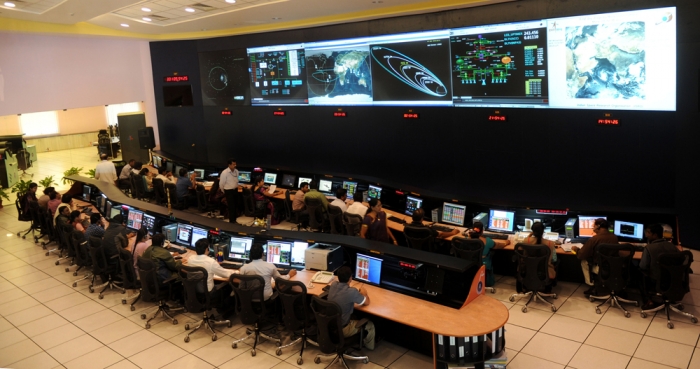RGB Spectrum Helps India Explore Mars
“India has successfully reached Mars!” declared Indian Prime Minister Narendra Modi, as the Indian Space Research Organization (ISRO) successfully placed a satellite into Martian orbit. “History has been created today. We have dared to reach out into the unknown and have achieved the near-impossible. I congratulate all ISRO scientists as well as all my fellow Indians on this historic occasion” (“History Created as India Dares Unknown”; www.universetoday.com).
At ISRO’s Telemetry, Tracking and Command Network (ISTRAC) facility, a large crowd of onlookers, including the Prime Minister and other dignitaries, watched the historic events unfold on a 1x6 array of projector screens. Powered by RGB Spectrum’s MediaWall Display Processor, ISTRAC’s high-definition display system continually monitored the satellite’s trajectory to ensure the success of the Mars Orbiter Mission (MOM).
RGB Spectrum partner Kiran Infosystems choose the MediaWall processor for its superior image quality and real-time performance. “This mission-critical control room is meant for demanding 24/7 requirements” remarked Ashish Shah, President of Kiran Infosystems. “Since 2010, RGB Spectrum’s MediaWall processor has delivered an unmatched level of reliability and operational excellence. The processor provides real-time, crystal clear imagery that allows ISTRAC operators to collaborate and share mission data in an environment where every detail counts. It has been a key contributor to the success of the Mars mission. We are proud that our partnership with ISRO has allowed us and RGB Spectrum to be part of this ground-breaking historical moment.”
India’s MOM began its journey on November 5, 2013 from the Satish Dhawan Space Center in Sriharikota, India. The $73 million, car-sized satellite took just over 10 months to travel a distance of 442 million miles before performing a complex maneuver to enter Mars’ orbit on September 23, 2014. The detailed, imagery provided by the MediaWall processor allowed ISTRAC operators to monitor the satellite during every stage of the journey.
For the next six months, the orbiting MOM probe will undertake a study of the Martian surface and atmosphere, sending high-definition video and telemetry information back to ISTRAC via a 105-foot diameter Indian Deep Space Network (IDSN) antenna.
The ISTRAC control room provides monitoring support for low-orbiting earth satellites as well as for launch missions like the MOM. ISTRAC receives satellite information from a network of Indian ground stations located in Bangalore, Lucknow, Sriharikota, Port Blair and Thiruvananthapuram, as well as from international stations in Mauritius, Russia, Brunei and Indonesia. Each ground station receives data from the IDSN antenna while a monitored satellite is within its range, and transmits this information to the ISTRAC facility for monitoring and analysis.
The display system consists of an array of six 120” rear projection screens mounted above operator stations. Signals from critical stations are routed through a switcher to the MediaWall processor for display on the video wall array. The control room is designed so that operators can monitor data at their own workstations and collaboratively view the most critical information on the video wall.
Offering unsurpassed power, clarity and reliability, our MediaWall display processors are an ideal choice for mission-critical control rooms, including space launch facilities like ISRO’s in India and NASA’s in the US. RGB Spectrum is truly honored that our MediaWall processor was an integral part of this historic event.
RGB Spectrum is a leading designer and manufacturer of mission-critical, real-time audio-visual solutions for a civilian, government, and military client base. The company offers integrated hardware, software, and control systems to satisfy the most demanding requirements. Since 1987, RGB Spectrum has been dedicated to helping its customers achieve Better Decisions. Faster.™


